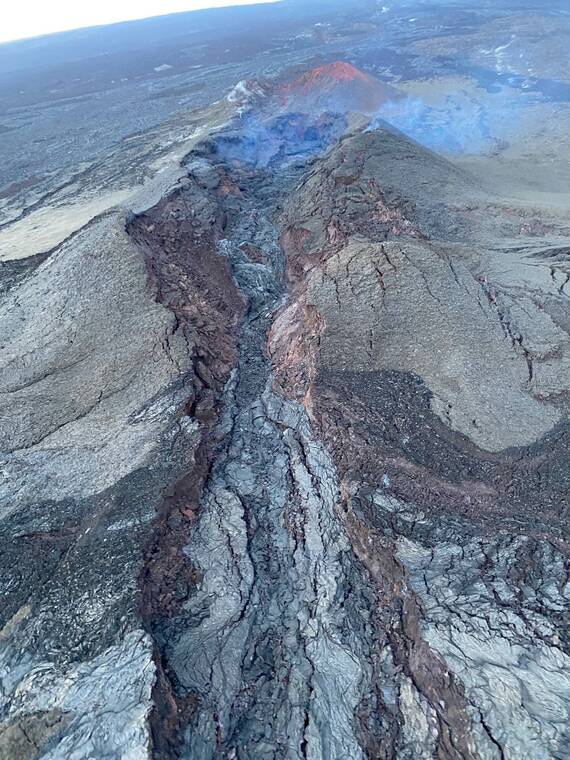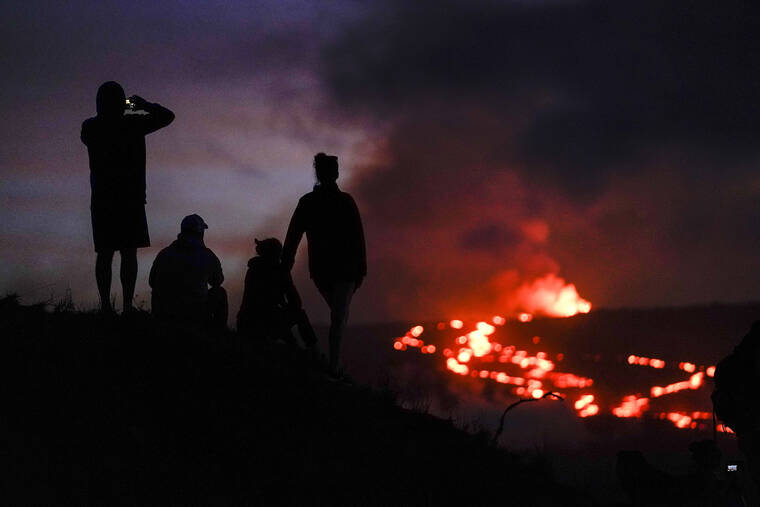ERUPTIONS PAU: Mauna Loa, Kilauea take a break at nearly the same time, says HVO

USGS/HVO Frank Trusdell — Fissure 3 on Mauna Loa displays no lava activity on Monday.

In this Dec. 1 photo, people watch lava from the Mauna Loa eruption. (AP Photo/Gregory Bull, File)
Mauna Loa and Kilauea volcanoes almost simultaneously have stopped erupting.
Mauna Loa and Kilauea volcanoes almost simultaneously have stopped erupting.
Hawaiian Volcano Observatory reported Tuesday that on Mauna Loa’s northeast flank, Fissure 3 stopped emitting lava on Saturday, and sulfur dioxide emissions diminished over the following days to levels similar to before the eruption began.
ADVERTISING
And on Kilauea, the lava supply to Halema‘uma‘u ceased Friday.
In response, HVO lowered its alert levels for both eruptions from Watch to Advisory.
HVO Scientist in Charge Ken Hon said that although the Kilauea eruption, which began Sept. 29, 2021, could restart given its continued seismicity, the Mauna Loa eruption, which began Nov. 27, has “paused, probably permanently.”
“There is no historical analogue for a Northeast Rift Zone eruption pausing like this and then restarting,” Hon said.
However, HVO will not declare either eruption officially over until at least three months have passed, he said.
Hon said it is noteworthy that both eruptions paused at almost the same time, and hypothesized that there might be some sort of underground expansion wherein Kilauea’s and Mauna Loa’s magma “plumbing” intersected.
But he added that seismicity and tremors under Kilauea had been diminishing for weeks preceding the Mauna Loa eruption, suggesting Kilauea was heading toward a pause even as Mauna Loa was preparing to erupt.
More observations will be necessary to determine what, if any, connection between the two eruptions exists, Hon said.
Hon also said that despite the Mauna Loa eruption being the first in 38 years, it fit in very neatly among historical eruptions. Hon said repeatedly during the eruption that most Northeast Rift Zone eruptions typically only last about two to three weeks, and the latest eruption paused after 16 days.
The Mauna Loa eruption also produced somewhere between 200 million and 250 million cubic meters of material, about one-fifth the amount produced during the 2018 Kilauea eruption.
“This was definitely my favorite volcanic eruption, even if I didn’t get to go out to see it much, since it didn’t threaten any communities,” Hon said.
With the end of both eruptions, the island is winding back down to a state of normalcy.
The Traffic Hazard Mitigation Route, which opened on Old Saddle Road within the Pohakuloa Training Area to give drivers a safe way to view the lava, will close after Thursday night.
Civil Defense Administrator Talmadge Magno said the route will be open tonight and Thursday from 4 p.m. to midnight, but will be shut down after that.
Lt. Col. Kevin Cronin, garrison commander for the U.S. Army’s Pohakuloa Training Area, said a little less than 30,000 vehicles traversed the mitigation route since it opened.
“If you figure three people per vehicle, that’s a lot of people,” Cronin said.
Cronin credited the success of the mitigation route to the close relationships between the Army and the county and state governments.
“(Mayor Mitch) Roth gave me a call one evening and asked me what I thought about Old Saddle Road,” Cronin said. “He came up and drove down it that night, and he said he thought it would work great, and I agreed, and we were off to the races from there. … In the Army, we say we move at the speed of trust, and that’s what happened here.”
Even though allowing community access to PTA in such a way was highly unusual, Cronin said there was only one incident in which lava viewers trespassed onto PTA land.
“It’s been such a special experience to see this happen, and I’m proud to have been a part of the team doing this,” said Cronin, who took over as garrison commander in June 2021. “I took my family down the mitigation route one night, and it was incredible to see.”
Even after the mitigation route closes, the Gilbert Kahele Recreational Area will remain open 24 hours a day, although visitors are recommended to only stay for 90 minutes or less because of anticipated heavy traffic.
The Mauna Loa Observatory Access Road, which was cut off by lava from Mauna Loa, will remain closed for the time being.
At Hawaii Volcanoes National Park, where two eruptions were visible simultaneously for the first time since 1983, some guests are already disappointed they missed the spectacle, said park spokeswoman Jessica Ferracane.
“But, we’re reminding them there’s still plenty to see here,” Ferracane said. “And Kilauea’s unpredictable. There may be a pause now, but we don’t know when it will start up again.”
Ferracane said the twin eruptions led to a steady but manageable stream of visitors to the park, but not as much of an increase as might have been expected — probably because the Mauna Loa lava was so easily viewable elsewhere, she speculated.
“But, it’s been an amazing sight to behold,” Ferracane said.
Email Michael Brestovansky at mbrestovansky@hawaiitribune-herald.com.


